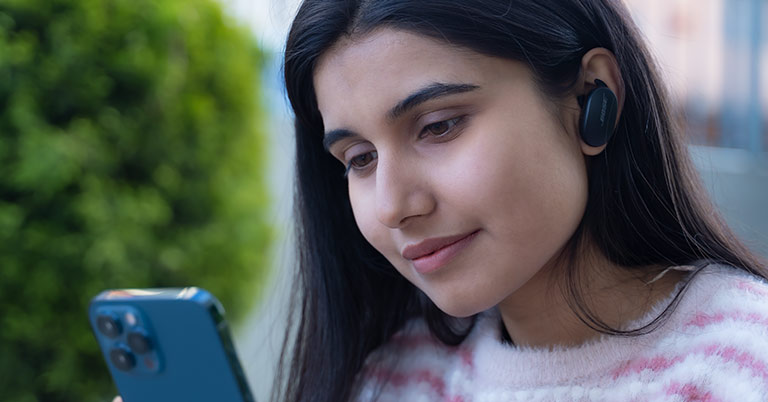
First Sony, now Apple—the company that pioneered it all had been losing its grip in the world of noise-canceling headphones and in-ear earphones. Yes, I’m talking about Bose. These days, Sony’s WF-1000XM3 and Apple’s AirPods Pro rank among the best ANC-enabled wireless earbuds in the market. But Bose isn’t one to sit quietly for long either. So, the company finally made a move into the premium TWS market with the QuietComfort Earbuds, which is also the first wireless earbuds from Bose to feature active noise cancellation. Priced higher than both of its aforementioned competition, these set of earbuds had big shoes to fill. And for what it’s worth, Bose has hit a home run with the QuietComfort Earbuds so let’s learn more about it in this review.
Bose QuietComfort Earbuds Specifications:
- Body: 1.54H x 1.02W x 1.06D-inches, 8.50 grams each
- Charging case: 1.25H x 3.50W x 2.00D-inches, Hard plastic
- Material: Plastic / Gold plating / Polymer coating
- Eartips: StayHear Max tips (Silicone)
- Equalizer: Active EQ
- Connectivity: Bluetooth 5.1 (Up to 30ft)
- Codec: SBC, AAC
- Battery backup: Up to 6 hours (additional 12 hours from charging case)
- Charging Time: 2 hours (earbuds); 3 hours (charging case)
- Noise cancellation: Yes, 11-level Active Noise Cancellation
- IP certification: Yes, IPX4
- Control: Touch
- Companion app: Bose Music (Android | iOS)
- Price in Nepal: Rs. 48,000
- Buy here (EvoStore)
Bose QuietComfort Earbuds Review:
Design & Comfort
- Big, bulky earbuds and charging case
- Soft, comfortable StayHear ear tips
As usual, let’s start things with design. Right away, one can tell that these earbuds mean business. I mean… just look at its sheer size. Subtlety is definitely not what the engineers at Bose had in mind when designing the QuietComfort Earbuds. These things look absolutely massive and the AirPods Pro that we also have just… fades away in terms of their physical size. Obviously, there’s a method to this madness, which I’ll get into in just a bit.
![QC Earbuds - Design [2]](https://cdn.gadgetbytenepal.com/wp-content/uploads/2021/01/QuietComfort-Earbuds-Design-2.jpg)
Weighing 8.5 grams each, these are certainly not the most lightweight earbuds you could buy right now. While Apple’s AirPods Pro scales to 5.4 grams, Bose’s answer reminds me of the Sony WF-1000XM3 instead. However, even though I faced issues with fit and comfort on the latter, Bose has managed to dodge that bullet by a fair margin. Its soft StayHear Max ear tip was surprisingly easy on my ears and throughout my usage, I didn’t face any concerning level of discomfort.
Finding comfort in QuietComfort
Having said that, your ears will express a sigh of relief once you take these earbuds out. For those accustomed to lightweight wireless earbuds, the Bose QuietComfort will be a difficult pill to swallow. I’ll admit I had to change the ear tip to size 1 (of 3) since the pre-installed one was rather big for my ears. Bose also encourages you to swap around different sizes for optimal fit. But thankfully, I found my right fit on a single try.
Anyway, once you get the right fit, these indeed feel quite comfortable in the ears and don’t come off that easy either—plus, the passive noise isolation itself is pretty good as well. Every surface of the earbuds—from the ear tips to the fins are made from soft silicone. I’m personally fond of how you don’t need to jam it further inside the ears for an optimal fit like with other in-ear earbuds. Additionally, these are also IPX4 sweat and water-resistant, allowing you to take it to your exercise, gym sessions with no worry.
Charging case
Likewise, QuietComfort Earbuds’ gargantuan charging case disregards any hint of subtlety or easy-going aesthetics too. For what’s supposed to be a pocketable product, these are definitely not shaped that way. If you don’t mind the bulge, that’s great—although I feel like most of us would be more comfortable with storing it in our backpack when not in use instead.
![QC Earbuds - Case [1]](https://cdn.gadgetbytenepal.com/wp-content/uploads/2021/01/QuietComfort-Earbuds-Case-1.jpg)
Regardless, its hard plastic build feels pretty premium. There’s a button on the front of the case that you gotta press to unlock the earbuds themselves. While practically every other pair of earbuds I’ve used up to this point have had a simple magnetic lid, Bose has outdone the competition with something that echoes durability & quality.
Pressing the button firmly releases the latch holding down the case and interestingly, it also has a dedicated Bluetooth button for first-time pairing. Another unusual trait on a premium set of wireless earbuds. Similarly, the front of the case also features a row of LED battery indicators. The top of the case has the Bose logo etched-in, whereas the back houses a USB-C port for charging. As expected from premium wireless earbuds, these support Qi-certified wireless charging too.
Pairing
- Bluetooth v5.1 wireless connection
- Up to 30 feet of effective range
Moving on to the pairing side of things, Bose QuietComfort Earbuds come with Bluetooth 5.1. Sadly, there’s no NFC connectivity like the Sony WF-1000XM3. Still, I found Bluetooth pairing to be adequately efficient and fast enough so I can discount the lack of NFC option on these earbuds. The company promises a strong connection within 30 feet of your device. While that’s never going to translate perfectly in a real-life scenario, I found their effective range to be more than sufficient.
![QC Earbuds - Charging Case [2]](https://cdn.gadgetbytenepal.com/wp-content/uploads/2021/01/QuietComfort-Earbuds-Charging-Case-2.jpg)
But I have to mention that for reason(s) unknown, our review unit of the Bose QuietComfort Earbuds failed to pair to my phone on the first try. Only after resetting my phone’s Bluetooth setting, I was able to successfully connect to these earbuds. I didn’t face a similar issue hereon after so that’s great.
Also, it establishes a connection with a device almost instantaneously after opening the lid. Besides NFC, another premium feature that’s missing from these earbuds is a multi-point connection. For instance, while the Jabra Elite 75T can be paired with two devices at the same time for maximum flexibility, you’ll need to manually switch the connection on the Bose QuietComfort Earbuds.
Controls
- A touch interface on each earbud
- Wear-detection support
Getting to controls, these wireless earbuds feature a touch interface on both sides. From tap, swipe, to long-press—it makes use of all these gestures for different actions. Despite all this, it still lacks the ability to go back to the previous track, which is my only complaint with the onboard control options. Here, you can double-tap the right earbud to play/pause a track or answer a phone call, while the same action on the left earbud toggles between three levels of noise-cancellation presets.
Similarly, long-pressing the right earbuds can trigger your phone’s voice assistant or decline a call. On the other hand, you can customize to either skip a track or check the battery level on the Bose Music app by long-pressing the left earbud. Finally, it lets you change the volume level by swiping up/down the right earbud.
![QuietComfort Earbuds - Design [1]](https://cdn.gadgetbytenepal.com/wp-content/uploads/2021/01/QuietComfort-Earbuds-Design-1.jpg)
However, you’ll need to specifically turn this feature on inside the app before being able to use it. That’s because, as it turns out, this feature wasn’t available at launch. On a couple of occasions, the swipe gesture did give up on me (rather erratically) and there would be a sudden burst or fall in volume level. Besides this, I don’t have anything else to complain about its controls.
Furthermore, it also supports wear-detection and will automatically adjust playback depending on whether you have them on your ears or not. To complement this feature, on top of pausing the music, Bose also automatically dials down the ANC level to 0 on one earbud in case you take the other one out.
Noise Cancellation
- 11-levels of Active Noise Cancellation
- Transparency/ambient mode
With all the nitty-gritty details aside, let us finally get into the noise-canceling properties of the QuietComfort Earbuds. Because Bose is almost synonymous with this tech, I had high hopes from these wireless earbuds; and I’m glad to report that it holds its ground. To further test its noise-canceling capabilities, I compared it against Apple’s AirPods Pro.
And yes, this one definitely does a better job at concealing your ears from the ambient noise. Featuring 4 microphones in total, the Bose QuietComfort Earbuds manages to deliver an impressive (if not, the best) noise-cancellation I’ve ever heard from a pair of wireless earbuds.
On occasions where certain white noises like the TV playing or people talking manages to lightly pass through the AirPods Pro, the one from Bose remains effectively silent. And there’s a distinct property to the noise that ultimately manages to slip inside these two earbuds too. While the QuietComfort Earbuds sounds natural and lively, noise on the AirPods Pro comes off relatively distant and at times, tinny.
Maybe I’m painting out the difference between the two to be incredibly vast—but when using them side-by-side, it certainly feels that way. Still, I don’t mean to say that the AirPods Pro’s ANC is downright ineligible.
ANC champion
During my test, I also took them down the rowdy streets of Kathmandu to find out which one’s better. Unsurprisingly, Bose seems to have figured out how to handle noise-cancellation in all types of scenarios. From the noise of the incoming traffic to other street noises, it’s marginally, yet significantly quieter on the QuietComfort Earbuds. But when you want to hear the outside world, you can toggle the ANC level to 0, just like the Transparency Mode on the AirPods Pro.
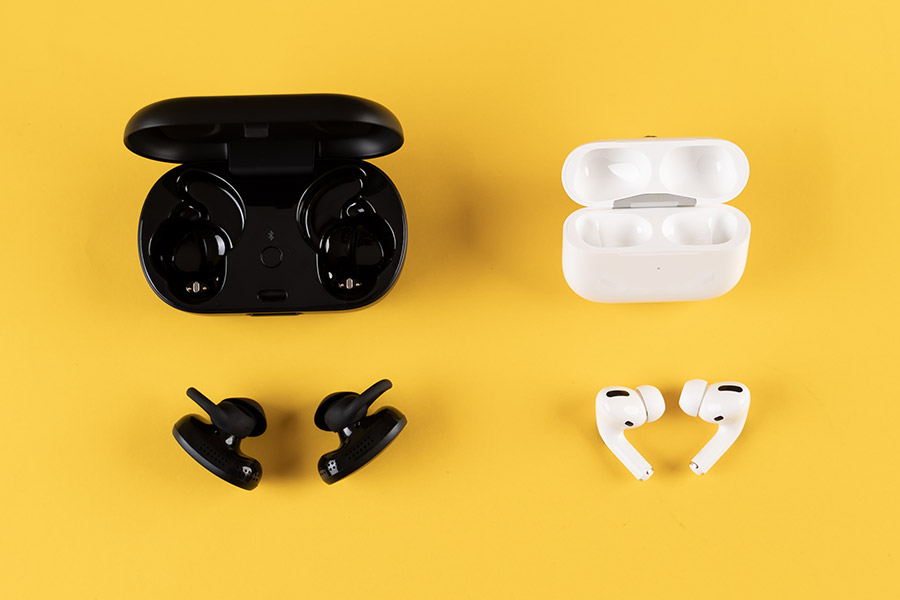
In this case, things are neck-and-neck between these wireless earbuds. I kinda prefer AirPods Pro’s transparency mode simply because it sounds a little louder and maybe even a tad bit more natural. Regardless, QuietComfort Earbuds’ ambient mode is a step above just on/off like on the AirPods Pro’s. You can save three “favorite” presets of noise-cancellation level, ranging from 0 to 10 (with 0 being the transparent mode and 10 being the highest level of ANC).
By default, the 3 presets feature 0, 5, and 10 levels of ANC and I left it be since that is pretty much what I’d want. Like I mentioned earlier, you can switch between these by double-tapping the left earbud. With each switch, there is an aural clue signaling you’ve toggled between the options. Nevertheless, I wish Bose went a step further to also denote what preset I’ve toggled to as well.
Audio, Call Quality
- SBC, AAC audio codecs
- 4 microphones in total
Stellar noise-cancellation aside, the QuietComfort Earbuds are no slouch when it comes to the audio quality either. Despite only supporting SBC and AAC codecs, it offers a rich, vibrant sound that you’d expect from a premium pair of wireless earbuds. There is no onboard equalizer in the Bose Music app. So, if the default sound profile is not up to your mark, you’re gonna have to look for third-party apps. In my case, I enjoyed the music as is and didn’t feel the need to tweak around the EQ.
When talking about audio, Bose boldly claims that the QuietComfort Earbuds brings unmatched listening experience. More specifically, the Active EQ technology, which dynamically adjusts the audio frequency range depending upon your volume level, is something of a head-turner. Thanks to this, even in the low volume, I could enjoy the music in its full glory—but not all the time.
For instance, in Fleetwood Mac’s “The Chain”, even the bass notes starting at the 3:05 mark are noticeable on these earbuds; while the same song sounds almost flat on the AirPods Pro on low volume. In “I Love You Like An Alcoholic” by The Taxpayers, a similar level of detail is marginally missed and at times, the bass can get muddy.
No spatial audio
Cranking up the loudness, the sound quality is natural, spacious, and not-at-all piercing—even though it doesn’t have any form of 360º or spatial audio algorithm. Listening to the same song on maximum volume, these two earbuds sound almost identical. But on certain occasions throughout the review period, I could notice that the Bose QuietComfort Earbuds sounded slightly punchier. Instrumental separation is fantastic as well and so are the mids and highs.
![QC Earbuds - Charging Case [3]](https://cdn.gadgetbytenepal.com/wp-content/uploads/2021/01/QuietComfort-Earbuds-Charging-Case-3.jpg)
Bass fanatics will come to love these earbuds too. Blade Runner 2049’s “Sea Wall” which starts off with mild synth bass and ghastly drum beats to epic bass notes and other details, these earbuds manage to pull-off rumbling low frequencies with great detail.
On to acoustic songs like “The Lonesome Death of Hattie Carroll” by Bob Dylan, I found the audio output to be slightly warmer and more natural on the QuietComfort Earbuds than the AirPods Pro. Also, at full volume, the occasional high-frequency harmonica comes off a-bit shrieky on the AirPods Pro and somewhat shadows the strings. All in all, Bose has nailed the sound profile on these earbuds on top of excellent noise-cancellation. Watching movies or other similar content is bliss as well and there is no latency; the audio and video sync up perfectly.
Call Quality
Moving on, QuietComfort Earbuds handles phone calls pretty well too. Thanks to the aforementioned microphone setup and the top-notch ANC, I received no complaint when calling different people. They’d describe my voice as clear, audible, and noise-free. There’s also this neat option inside the Bose Music app that allows you to switch how loudly you’d like to hear your voice—therefore preventing you from speaking too loud when unnecessary.
Battery Life
- Up to 6 hours playback (with ANC)
- USB-C, Qi wireless charging
Finally, let’s get into the battery life. And this might be the one area that Bose left me wanting for more. Even though 6 hours of claimed battery endurance is fairly common on wireless earbuds with ANC, considering its physical size, I wished it lasted a couple of hours more. Listening to music at 80-100% volume with ANC at level 10 (most of the time) and taking a couple of calls, I managed to get 5 – 5 and a half hours of juice. And if you’re in a hurry, 15-minutes of charge can get you 2 hours of playtime.
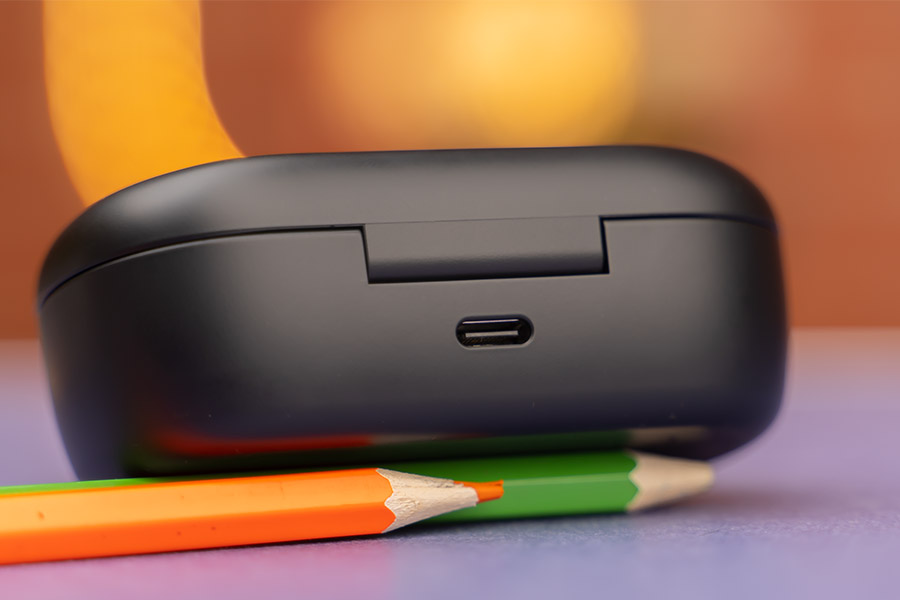
Charging up the QuietComfort Earbuds takes rather long though. Via the USB-C cable, it takes 2 hours to get the earbuds to 100%; whereas the case requires an hour more. The charging case adds 2 more cycles of charge time (i.e. 12 hours) so that’s nice. In addition to wired charging, you can also juice it up using a Qi-certified wireless charger.
Conclusion
To wrap it all up, as I’ve discussed throughout this review, the Bose QuietComfort Earbuds cements itself as the new champion in the premium noise-canceling wireless earbuds industry. Although the company was uncharacteristically late to enter this market, the excellence of the product more than makes up for the delay. Still and all, its bulky design could be an instant turn-off to many.
While its direct competition like Apple’s AirPods Pro offers a much sleeker build quality with a greater degree of comfort (and might I add, a cheaper asking price), the QuietComfort Earbuds has some work cut out for it. In a bid to provide first-class audio and ANC, Bose’s sacrifice of portability might not rub off on everyone the same way.
Songs referenced in the Bose QuietComfort Earbuds review:
- Fleetwood Mac – The Chain
- The Taxpayers – I Love You Like An Alcoholic
- Hans Zimmer & Benjamin Wallfisch – Sea Wall
- Bob Dylan – The Lonesome Death of Hattie Carroll
Bose QuietComfort Earbuds Review: Pros & Cons
Pros:
- Best-in-class noise-cancellation
- Terrific audio even in low volumes
- Noise-free, clear, loud call quality
- Soft, comfortable earbuds design
- Intuitive, responsive touch controls
- IPX4 certified against water splashes
Cons:
- The bulky design might be off-putting
- No multi-point connection support
- No high bitrate audio codecs like LDAC
- Battery life could’ve been a little better











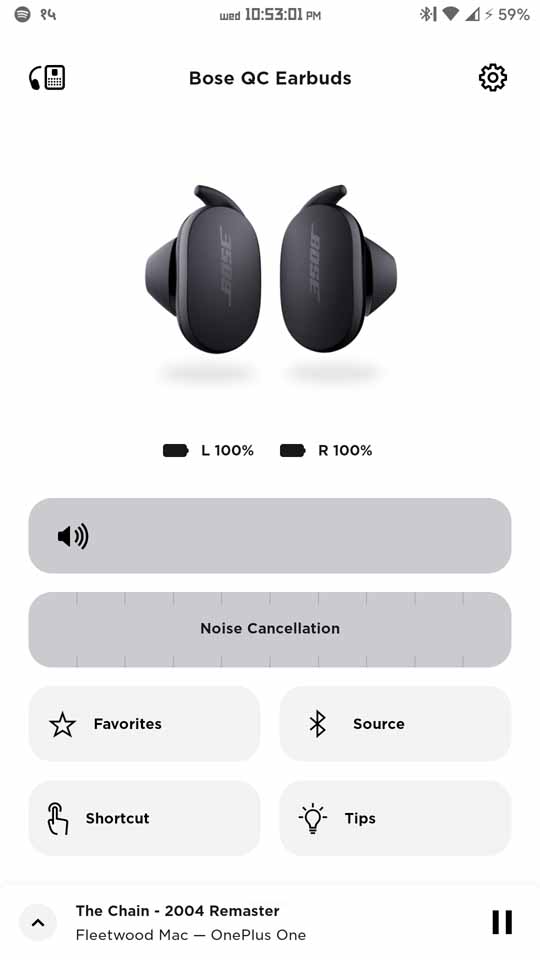
![Bose Music - Noise Cancellation [1]](https://cdn.gadgetbytenepal.com/wp-content/uploads/2021/01/Bose-Music-Noise-Cancellation-1.jpg)
![Bose Music - Noise Cancellation [2]](https://cdn.gadgetbytenepal.com/wp-content/uploads/2021/01/Bose-Music-Noise-Cancellation-2.jpg)
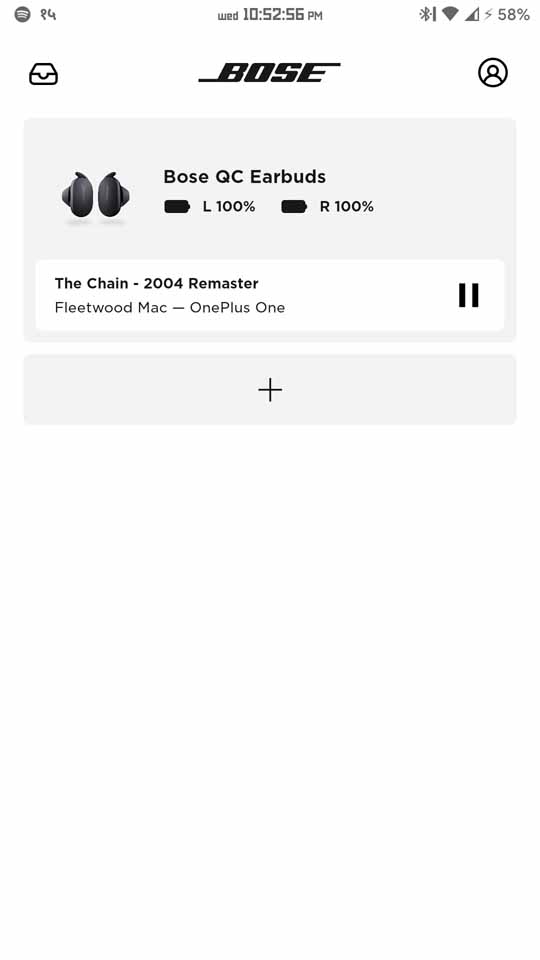

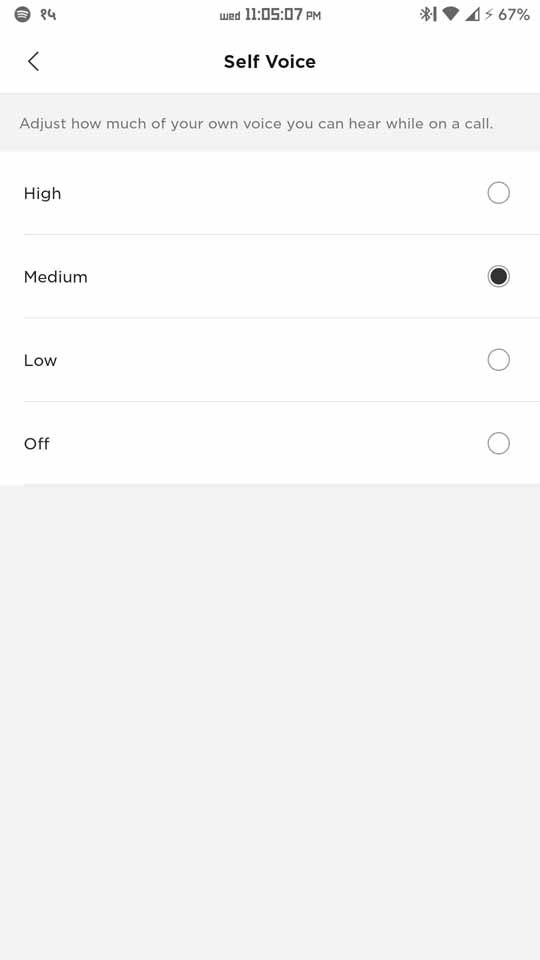





![Best Ultrabooks To Buy in Nepal 2024 [Updated] Best Ultrabook Laptops in Nepal 2023 - June Update](https://cdn.gadgetbytenepal.com/wp-content/uploads/2023/04/Best-Ultrabook-Laptops-in-Nepal-2023-June-Update.jpg)
![Best Gaming Laptops in Nepal 2024 [Updated] Best Gaming Laptops in Nepal 2023 - June Update](https://cdn.gadgetbytenepal.com/wp-content/uploads/2023/04/Best-Gaming-Laptops-in-Nepal-2023-June-Update.jpg)


![Best Mobile Phones Under Rs. 15,000 in Nepal [Updated] Best Phones Under 15000 in Nepal 2024 Budget Smartphones Cheap Affordable](https://cdn.gadgetbytenepal.com/wp-content/uploads/2024/03/Best-Phones-Under-15000-in-Nepal-2024.jpg)
![Best Mobile Phones Under Rs. 20,000 in Nepal [Updated] Best Mobile Phones Under NPR 20000 in Nepal 2023 Updated Samsung Xiaomi Redmi POCO Realme Narzo Benco](https://cdn.gadgetbytenepal.com/wp-content/uploads/2024/01/Best-Phones-Under-20000-in-Nepal-2024.jpg)
![Best Mobile Phones Under Rs. 30,000 in Nepal [Updated]](https://cdn.gadgetbytenepal.com/wp-content/uploads/2023/12/Best-Phones-Under-30000-in-Nepal-2024.jpg)
![Best Mobile Phones Under Rs. 40,000 in Nepal [Updated] Best Phones Under 40000 in Nepal 2024 Smartphones Mobile Midrange](https://cdn.gadgetbytenepal.com/wp-content/uploads/2024/02/Best-Phones-Under-40000-in-Nepal-2024.jpg)
![Best Mobile Phones Under Rs. 50,000 in Nepal [Updated] Best Phones Under 50000 in Nepal 2024 Smartphones Midrange](https://cdn.gadgetbytenepal.com/wp-content/uploads/2024/02/Best-Phones-Under-50000-in-Nepal-2024.jpg)
![Best Flagship Smartphones To Buy In Nepal [Updated] Best Smartphones in Nepal 2024 Flagship Premium Samsung Apple iPhone Xiaomi OnePlus Honor](https://cdn.gadgetbytenepal.com/wp-content/uploads/2023/09/Best-Smartphones-in-Nepal-2024.jpg)